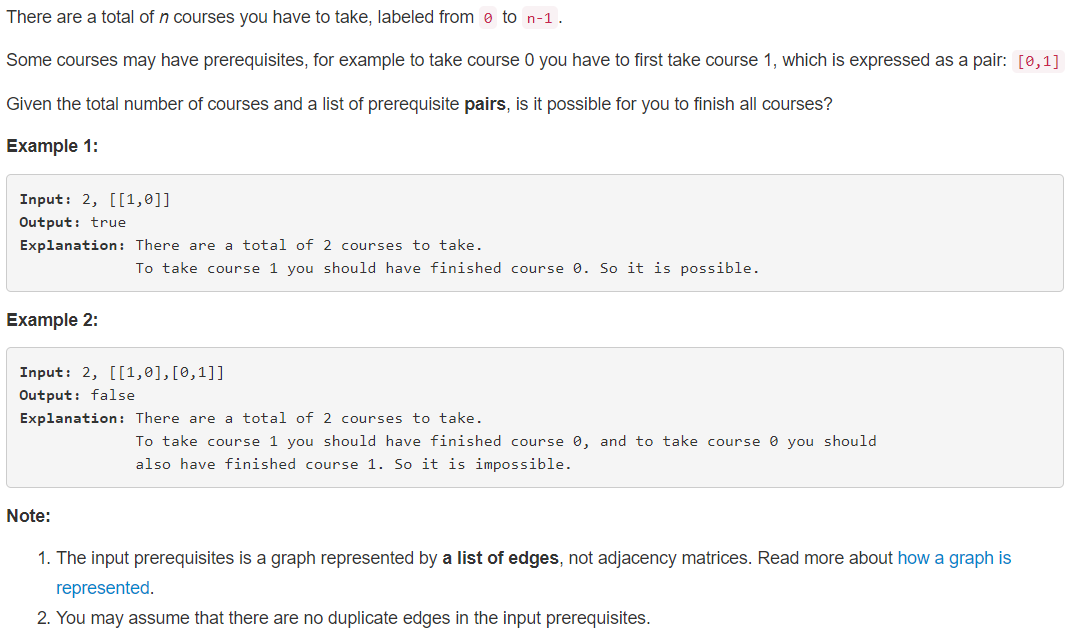一、题目
1、审题

2、分析
给出顶点数、指向当前顶点的前驱顶点,判断当前顶点组成的图是否是一个有向无环图。
二、解答
1、思路:
方法一、
采用拓扑排序
①、定义数组 matrix[][] 存储从 i 指向 j 的边,curArr[] 存储指向当前顶点的边数。并初始化这两个数组;
②、将没有前驱的顶点存入队列中,依次出列;
③、将出列的顶点为起始的边依次去除,即将 curArr[i] 值 -1;若 curArr[i] == 0,则 i 入队列;
④、最终队列为空时,若总共入队的元素个数与顶点个数相等,则为有向无环图,否则,为有环图。
public boolean canFinish2(int numCourses, int[][] prerequisites) { int[][] matrix = new int[numCourses][numCourses]; // 存储边 int[] curArr = new int[numCourses]; // curArr[m] = n: 有 n 个指针指向 m for (int i = 0; i < prerequisites.length; i++) { int pre = prerequisites[i][1]; int cur = prerequisites[i][0]; if(matrix[pre][cur] == 0) curArr[cur] = 1; matrix[pre][cur] = 1; } Queue<Integer> queue = new LinkedList<>(); for (int i = 0; i < numCourses; i++) { if(curArr[i] == 0) queue.offer(i); } int count = 0; while(!queue.isEmpty()) { count++; int course = queue.poll(); for (int i = 0; i < numCourses; i++) { if(matrix[course][i] != 0 && --curArr[i] == 0) queue.offer(i); } } return count == numCourses; }
方法二、
采用 DFS
①、首先构造图,用 Map 存储,Key 为顶点,value 为直接前驱顶点;
②、往前驱顶点进行深度遍历图中每个顶点,判断是否该顶点重复出现,若是,返回 false;
③、遍历完途中的所有顶点,返回 true;
public boolean canFinish(int numCourses, int[][] prerequisites) { if(prerequisites == null) return false; // key: 当前顶点, value: 所有直接前驱顶点 HashMap<Integer, List<Integer>> grap = new HashMap<>(); for(int[] curPair: prerequisites) { List<Integer> match = grap.get(curPair[0]); if(match == null) { match = new ArrayList<Integer>(); match.add(curPair[1]); grap.put(curPair[0], match); } else { match.add(curPair[1]); } } HashSet<Integer> prevRoots = new HashSet<>(); for(Integer curRoot: grap.keySet()) { boolean[] hasCircle = new boolean[1]; DFS(prevRoots, curRoot, grap, hasCircle); if(hasCircle[0]) return false; } return true; } private void DFS(HashSet<Integer> prevRoots, Integer start, HashMap<Integer, List<Integer>> grap, boolean[] hasCircle) { if(hasCircle[0]) // 跳出条件 return; else if(prevRoots.contains(start)) { hasCircle[0] = true; return; } prevRoots.add(start); List<Integer> match = grap.get(start); if(match != null) { for(Integer newStart: match) DFS(prevRoots, newStart, grap, hasCircle); } prevRoots.remove(start); }